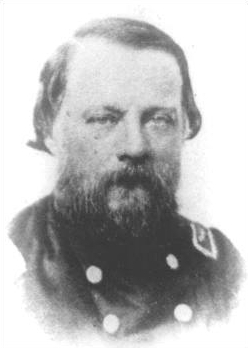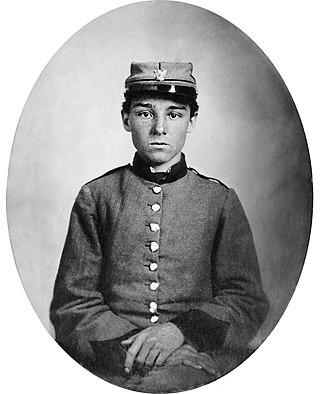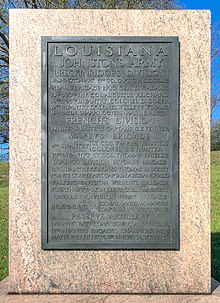The 1st Missouri Infantry was an infantry regiment that served in the Confederate States Army during the American Civil War. Originally commanded by Colonel John S. Bowen, the regiment fought at the Battle of Shiloh, where it was engaged near the Peach Orchard on April 6, 1862. On April 7, during the Union counterattacks at Shiloh, the regiment was instrumental in preventing the Washington Artillery from being captured. The regiment was next engaged at the Second Battle of Corinth, where it outflanked several Union positions. On the second day at Corinth, the regiment was only minimally engaged. On November 7, the 1st Missouri Infantry was combined with the 4th Missouri Infantry to form the 1st and 4th Missouri Infantry (Consolidated), as a result of heavy battle losses in both regiments.

The 7th Texas Infantry Regiment was a unit of Confederate States Army infantry volunteers organized in 1861 that fought mostly in the Army of Tennessee during the American Civil War. The regiment was captured at Fort Donelson in 1862 and sent to Northern prison camps. After the survivors were exchanged and new recruits added, the regiment was reconstituted and fought at Raymond, Jackson, Chickamauga, Missionary Ridge, and Ringgold Gap in 1863. The unit served in the Atlanta Campaign and at Franklin, Nashville, Averasborough, and Bentonville in 1864–1865. The regiment's 65 survivors surrendered to William Tecumseh Sherman's Federal forces on 26 April 1865.

The 9th Texas Infantry Regiment was a unit of Confederate States Army infantry volunteers organized in December 1861 that fought during the American Civil War. The regiment fought at Shiloh, Perryville, and Stones River in 1862, Chickamauga in 1863, the Atlanta Campaign, Allatoona, and Nashville in 1864, and Spanish Fort and Fort Blakeley in 1865. The remaining 87 officers and men surrendered to Federal forces in May 1865. Two of the regiment's commanding officers were promoted brigadier general.
The 19th Louisiana Infantry Regiment was an infantry regiment from Louisiana that served in the Confederate States Army during the American Civil War.

The 3rd Louisiana Infantry Regiment was a unit of foot soldiers from Louisiana that fought in the Confederate States Army during the American Civil War. The regiment distinguished itself at Wilson's Creek in 1861. The 3rd Louisiana fought at Pea Ridge, First Corinth, Iuka, and Second Corinth in 1862. The unit defended Vicksburg in 1863 where it was captured. At Vicksburg, the unit's fortification was twice blown up by powerful land mines. The surviving soldiers were paroled and exchanged, after which they performed guard duty for the rest of the war.
The 1st and 4th Missouri Infantry (Consolidated) was an infantry regiment that served in the Confederate States Army during the American Civil War. The regiment was formed on November 7, 1862 when the 1st Missouri Infantry and the 4th Missouri Infantry were consolidated as a result of heavy battle losses in both units. The regiment served in several battles in the 1863 Vicksburg campaign, including a charge that almost broke the Union line at the Battle of Champion Hill. When the Siege of Vicksburg ended with a Confederate surrender, the regiment was captured and later exchanged. In 1864, the regiment fought in the Atlanta campaign, and suffered heavy losses at the Battle of Franklin. On April 9, 1865, the regiment surrendered at the Battle of Fort Blakely, and was paroled in May when the war ended for all effective purposes.
The 4th Missouri Infantry Regiment was formed on April 28, 1862, and served in the Confederate States Army during the American Civil War. The infantry regiment did not see action at the Battle of Farmington on May 9, and the Battle of Iuka on September 19 despite being part of the Confederate force present at those battles. As part of Brigadier General Martin E. Green's brigade, the regiment participated in three charges against Union lines on October 3, 1862, during the Second Battle of Corinth. The following day, the regiment, along with the rest of Green's brigade, attacked the new Union lines. Despite initial success, the attack was repulsed by a Union counterattack. The regiment ceased to exist as a separate unit when it was combined with the 1st Missouri Infantry Regiment on November 7, 1862, to form the 1st and 4th Missouri Infantry Regiment (Consolidated).

The 24th and 25th Consolidated Texas Cavalry Regiment was a unit that originally consisted of two regiments of mounted volunteers that served in the Confederate States Army during the American Civil War. However, by the time the two regiments were consolidated, they fought as infantry. Both regiments organized as cavalry near Hempstead, Texas in April 1862 and were dismounted to fight as infantry in July 1862. The two regiments served in the same brigade and were captured at the Battle of Arkansas Post in January 1863. After being sent to Northern prison camps, the soldiers were exchanged in April 1863. Assigned to the Army of Tennessee, the two regiments were consolidated with two additional Texas cavalry regiments and in 1863 fought as infantry at Liberty Gap, Chickamauga, Missionary Ridge, and Ringgold Gap. In 1864, the other two Texas regiments were detached and the consolidated 24th and 25th fought as a separate infantry unit in the Atlanta campaign, at Franklin, and at Nashville. For the Carolinas campaign, the 24th and 25th fought at Bentonville before being reconsolidated with other Texas regiments and surrendering in April 1865.

The 18th Texas Infantry Regiment was a unit of volunteers recruited in Texas that fought in the Confederate States Army during the American Civil War. The regiment was enrolled in Confederate service in May 1862 and always campaigned west of the Mississippi River in the region known as the Trans-Mississippi Department. The unit was assigned to the Texas infantry division known as Walker's Greyhounds. The regiment fought at Milliken's Bend, Richmond (La.), and Bayou Bourbeux in 1863 and Mansfield, Pleasant Hill, and Jenkins' Ferry in 1864. The regiment disbanded in mid-May 1865, but its formal surrender date was 26 May 1865.

The 11th Texas Infantry Regiment was a unit of volunteers recruited in Texas that fought in the Confederate States Army during the American Civil War. The regiment organized in the winter of 1861–1862 and always served west of the Mississippi River in the Trans-Mississippi Department. The unit was assigned to the 2nd Brigade of the Texas infantry division known as Walker's Greyhounds. The regiment fought at Milliken's Bend and Bayou Bourbeux in 1863 and Mansfield, Pleasant Hill, and Jenkins' Ferry in 1864. The regiment disbanded in mid-May 1865, but its formal surrender date was 26 May 1865.

The 2nd Louisiana Cavalry Regiment was a unit of mounted volunteers recruited in Louisiana that fought in the Confederate States Army during the American Civil War. Breazeale's Cavalry Battalion was formed in July 1862 and was augmented by five additional companies in September 1862 to form a regiment. It served for the entire war west of the Mississippi River in the Trans-Mississippi Department. The regiment fought at Georgia Landing, Fort Bisland, Irish Bend, and Brashear City in 1863 and Henderson's Hill and Mansfield in 1864. Afterward, the regiment fought in minor skirmishes before the Trans-Mississippi's final surrender on 26 May 1865.

The 1st Louisiana Infantry Regiment was a unit of volunteers recruited in Louisiana that fought in the Confederate States Army during the American Civil War. Formed in April 1861, the regiment was sent to fight in the Eastern Theater of the American Civil War. Joining a brigade of Louisiana regiments, it fought at Malvern Hill, Second Bull Run, Antietam, and Fredericksburg in 1862, at Chancellorsville, Second Winchester, Gettysburg, and Mine Run in 1863, and at the Wilderness, Spotsylvania, Monocacy, Third Winchester, Fisher's Hill, Cedar Creek, and Petersburg in 1864, and at Appomattox in 1865. At Appomattox, the regiment was only a shadow of its former self.

The 2nd Louisiana Infantry Regiment was a unit of volunteers recruited in Louisiana that fought in the Confederate States Army during the American Civil War. Formed in May 1861, the regiment was sent to fight in the Eastern Theater of the American Civil War. Its first action took place during the Siege of Yorktown. The regiment suffered very heavy losses at Malvern Hill. After joining an all-Louisiana brigade, it fought at Cedar Mountain, Second Bull Run, Antietam, and Fredericksburg in 1862, at Chancellorsville, Second Winchester, Gettysburg, and Mine Run in 1863, and at the Wilderness, Spotsylvania, Cold Harbor, Monocacy, Third Winchester, Fisher's Hill, Cedar Creek, and Petersburg in 1864, and at Appomattox in 1865. The regiment lost over 100 men at both Second Bull Run and Chancellorsville. A company-sized remnant surrendered at Appomattox.

The 12th Louisiana Infantry Regiment was a unit of volunteers recruited in Louisiana that fought in the Confederate States Army during the American Civil War. Formed in August 1861, the regiment served in the Western Theater of the American Civil War and was unique in that there were 12 companies. The regiment garrisoned Island Number Ten before being stationed at Fort Pillow. It fought at Second Corinth in 1862 and Champion Hill and Jackson in 1863. A detachment served during the Siege of Vicksburg and was captured. In 1864, the regiment fought in the Meridian, Atlanta, and Franklin–Nashville campaigns, suffering heavy losses at Peachtree Creek and Franklin. It fought at Bentonville in 1865 before surrendering with General Joseph E. Johnston.

The 8th Louisiana Infantry Regiment was a unit of volunteers recruited in Louisiana that fought in the Confederate States Army during the American Civil War. Formed in June 1861, the regiment was sent to fight in the Eastern Theater of the American Civil War. Joining a brigade of Louisiana regiments, it fought in Jackson's Valley campaign and at Gaines' Mill, Malvern Hill, Second Bull Run, Antietam, and Fredericksburg in 1862. The regiment served at Chancellorsville, Second Winchester, Gettysburg in 1863. At Rappahannock Station in November 1863, most of the regiment was captured. The unit fought at the Wilderness, Spotsylvania, Cold Harbor, and the Valley campaigns of 1864. It served at Petersburg starting in December 1864 and surrendered at Appomattox in April 1865.

The 7th Louisiana Infantry Regiment was a unit of volunteers recruited in Louisiana that fought in the Confederate States Army during the American Civil War. Formed in June 1861, the regiment was sent to fight in the Eastern Theater of the American Civil War. After fighting at First Bull Run, the unit joined the 1st Louisiana Brigade. The regiment served in Jackson's Valley campaign and at Gaines' Mill, Malvern Hill, Cedar Mountain, Second Bull Run, Harpers Ferry, Antietam, and Fredericksburg in 1862. The regiment fought at Chancellorsville, Second Winchester, and Gettysburg in 1863. At Rappahannock Station in November 1863, almost the entire regiment was captured. The remnant of the unit fought at the Wilderness, Spotsylvania, Cold Harbor, and the Valley campaigns of 1864. It served at Petersburg starting in December 1864 and surrendered at Appomattox in April 1865.

The 20th Louisiana Infantry Regiment was a unit of volunteers recruited in Louisiana that fought in the Confederate States Army during the American Civil War. The unit began its existence as the 6th Louisiana Battalion in September 1861. The battalion was augmented to regimental strength in January 1862 at New Orleans and served during the war in the Western Theater of the American Civil War. The regiment fought at Shiloh, Farmington, and Perryville in 1862. After being reduced in numbers, the regiment was consolidated with the 13th Louisiana Infantry Regiment and served at Stones River, Jackson, Chickamauga, and Missionary Ridge in 1863. The 13th-20th Consolidated Louisiana fought at Resaca, New Hope Church, Ezra Church, and Nashville in 1864. The consolidation with the 13th Louisiana was discontinued in February 1865 and the regiment was re-consolidated with other units. It fought its final battle at Spanish Fort one month before surrendering in May 1865.

The 13th Louisiana Infantry Regiment was a unit of volunteers recruited in Louisiana that fought in the Confederate States Army during the American Civil War. The unit was created when four infantry companies were added to the Battalion of Governor's Guards in September 1861. It served during the war in the Western Theater of the American Civil War. The regiment fought at Shiloh, Farmington, and Perryville in 1862. After being reduced in numbers, the regiment was consolidated with the 20th Louisiana Infantry Regiment and served at Stones River, Jackson, Chickamauga, and Missionary Ridge in 1863. The 13th-20th Louisiana fought at Resaca, New Hope Church, Ezra Church, and Nashville in 1864. The consolidation with the 20th Louisiana was discontinued in February 1865 and the regiment was re-consolidated with other units. It fought its final battle at Spanish Fort one month before surrendering in May 1865.

The 30th Louisiana Infantry Regiment was a unit of volunteers recruited in Louisiana that fought in the Confederate States Army during the American Civil War. On 17 December 1861, the Sumter Regiment was accepted into state service at New Orleans. On 1 March 1862, the militia regiment transferred to Confederate service for a 90-day enlistment. At the Capture of New Orleans on 25 April, three and a half companies stayed in the city and were captured. The other companies went to Camp Moore where the regiment reorganized for Confederate service on 15 May 1862, by the addition of four more companies. Company K left on furlough and never returned. The regiment fought at Baton Rouge before being assigned to garrison Port Hudson. On 4 March 1863, two companies were suppressed and their men reassigned to other companies, officially reducing the regiment to a 7-company unit named the 30th Louisiana Infantry Battalion. However, contemporary records often continued to refer to the unit as a regiment. A detachment was captured at the Siege of Port Hudson, but the bulk of the battalion served at Jackson in 1863, and New Hope Church, Atlanta, Ezra Church, and Nashville in 1864. The survivors were consolidated with the remnants of the 4th and 13th Louisiana Infantry Regiments, and the 14th Louisiana Battalion in February 1864. The men fought at Spanish Fort in March and April 1865, and surrendered in May 1865.

The 13th and 20th Consolidated Louisiana Infantry Regiment was a unit of volunteers recruited in Louisiana that fought in the Confederate States Army during the American Civil War. It served only in the Western Theater. The unit was created in November 1862 by combining the veteran but diminished 13th Louisiana and 20th Louisiana Infantry Regiments to form the consolidated regiment. The regiment fought at Stones River, Jackson, Chickamauga, and Missionary Ridge in 1863. The 13th-20th Louisiana fought at Resaca, New Hope Church, Ezra Church, Jonesborough, and Nashville in 1864. The consolidation was discontinued in February 1865 and the 13th and 20th Infantry Regiments were re-consolidated with other units.



















